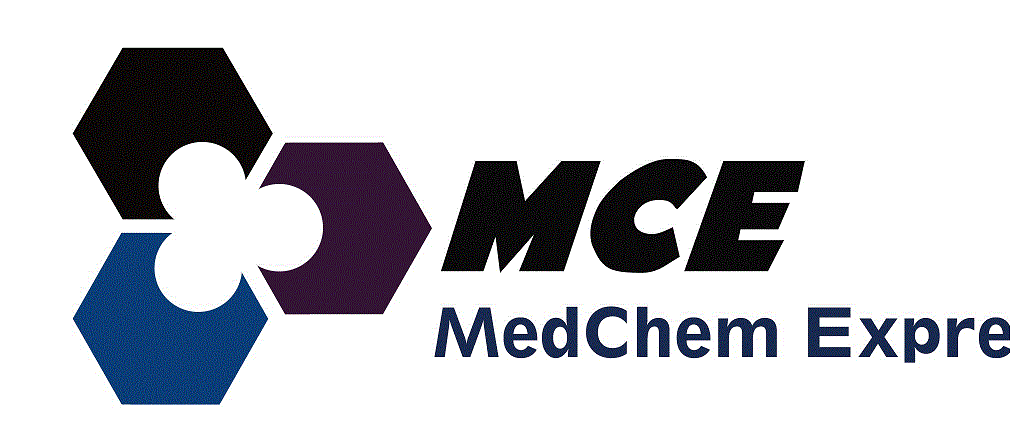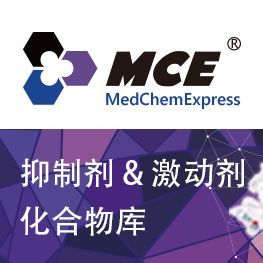MedChem Express
α1-2,4,6 Fucosidase O (EC 3.2.1.51) is a broad specificity exoglycosidase that catalyzes the hydrolysis of terminal α1-2, α1-4 and α1-6 linked fucose residues from oligosaccharides, with α1-6 fucose residues more efficiently[1].
More Information
Supplier Page
MedChem Express
α1-3,4 Fucosidase (EC 3.2.1.51) is a broad specificity exoglycosidase that catalyzes the hydrolysis of terminal, non-reducing α1-3 and α1-4 linked fucose residues from oligosaccharides and glycoproteins[1].
More Information
Supplier Page
MedChem Express
α1-3,4,6 Galactosidase is a broad specificity exoglycosidase that catalyzes the hydrolysis of terminal, non-reducing α1-3, α1-4 and α1-6-linked galactose residues from oligosaccharides[1].
More Information
Supplier Page
MedChem Express
α1-3,6 Galactosidase (EC 3.2.1.22) is a highly specific exoglycosidase that catalyzes the hydrolysis of α1-3 and α1-6 linked galactose residues from oligosaccharides[1].
More Information
Supplier Page
MedChem Express
α1-6 Mannosidase (EC 3.2.1.24) is a highly specific exoglycosidase that removes unbranched α1-6 linked mannose residues from oligosaccharides[1].
More Information
Supplier Page
MedChem Express
α1b-AR antagonist 1 (Compound Cpd1) is a selective α1B-AR antagonist. Alpha1b-ar antagonist 1 can be used in the study of cardiovascular and central nervous system diseases[1].
More Information
Supplier Page
MedChem Express
α2-3,6 Neuraminidase (EC 3.2.1.18) is a highly specific exoglycosidase that catalyzes the hydrolysis of non-reducing terminal α2-3 and α2-6 unbranched sialic acid residues from complex carbohydrates and glycoproteins. This enzyme does not exhibit activity on α2-8 or branched sialic acids[1].
More Information
Supplier Page
MedChem Express
α2-3,6 Neuraminidase (EC 3.2.1.18) is a highly specific exoglycosidase that catalyzes the hydrolysis of non-reducing terminal α2-3 and α2-6 unbranched sialic acid residues from complex carbohydrates and glycoproteins. This enzyme does not exhibit activity on α2-8 or branched sialic acids[1].
More Information
Supplier Page
MedChem Express
α2-3,6 Neuraminidase (EC 3.2.1.18) is a highly specific exoglycosidase that catalyzes the hydrolysis of non-reducing terminal α2-3 and α2-6 unbranched sialic acid residues from complex carbohydrates and glycoproteins. This enzyme does not exhibit activity on α2-8 or branched sialic acids[1].
More Information
Supplier Page
MedChem Express
alpha-2,3-Sialyltransferase (PmST1) (EC 2.4.99.4), a sialyltransferase, can be isolated from Pasteurella multocida. alpha-2,3-Sialyltransferase (PmST1) can be converted into regioselective α2-6-sialyltransferase by saturation mutagenesis and regioselective screening[1].
More Information
Supplier Page
MedChem Express
MedChem Express
MedChem Express
α7β1 integrin modulator-1 is a potent α7β1 integrin modulator. α7β1 integrin modulator-1 has the potential for the research of muscular dystrophy[1].
More Information
Supplier Page
MedChem Express
α7β1 integrin modulator-1 is a potent α7β1 integrin modulator. α7β1 integrin modulator-1 has the potential for the research of muscular dystrophy[1].
More Information
Supplier Page
MedChem Express
αA-Conotoxin OIVA (αA-OIVA) is a selective nAChR antagonist with an IC50 of 56 nM against mammalian fetal muscle nAChR. αA-Conotoxin OIVA is a peptide that can be derived from conotoxin. αA-Conotoxin OIVA paralyzes muscles[1][2].
More Information
Supplier Page
MedChem Express
αA-Conotoxin PIVA is a selective mouse musclenAChR inhibitor with IC50 for adult and fetal mouse musclenAChR sub> values are 2.3 nM and 22 nM respectively. αA-Conotoxin PIVA can be used in the study of neurological diseases.
More Information
Supplier Page
MedChem Express
αC-Conotoxin PrXA is a paralytic peptide neurotoxin and a competitive nAChR antagonist, with IC50s of 1.8 nM (α1β1εδ, adult) and 3.0 nM (α1β1γδ, fetal), respectively. αC-Conotoxin PrXA competes with α-bungarotoxin at the α/δ and α/γ subunit interfaces of the nAChR, shows high specificity against neuromuscular nAChR[1].
More Information
Supplier Page
MedChem Express
αC-Conotoxin PrXA is a paralytic peptide neurotoxin and a competitive nAChR antagonist, with IC50s of 1.8 nM (α1β1εδ, adult) and 3.0 nM (α1β1γδ, fetal), respectively. αC-Conotoxin PrXA competes with α-bungarotoxin at the α/δ and α/γ subunit interfaces of the nAChR, shows high specificity against neuromuscular nAChR[1].
More Information
Supplier Page
MedChem Express
αC-Conotoxin PrXA is a paralytic peptide neurotoxin and a competitive nAChR antagonist, with IC50s of 1.8 nM (α1β1εδ, adult) and 3.0 nM (α1β1γδ, fetal), respectively. αC-Conotoxin PrXA competes with α-bungarotoxin at the α/δ and α/γ subunit interfaces of the nAChR, shows high specificity against neuromuscular nAChR[1].
More Information
Supplier Page
MedChem Express
αO-Conotoxin GeXIVA is a potent α9α10 nAChR antagonist with an IC50 of 12 nM against rat α9α10. αO-Conotoxin GeXIVA shows analgesic in animal models of pain[1].
More Information
Supplier Page
MedChem Express
αvβ1 integrin-IN-2 (compound 32) is a potent inhibitor of integrins ανβ1 and α5β1 with IC50s of 0.9 nM,and 33 nM,respectively. αvβ1 integrin-IN-2 also inhibits other integrins with ,,IC50s of 380 nM (ανβ3),280 nM (ανβ5),230 nM (ανβ6),87 nM (ανβ8),respectively,in SPRA assay[1].
More Information
Supplier Page
MedChem Express
αvβ6 integrin inhibitor 2 is a potent ανβ6 integrin inhibitor with an IC50 of 96.5 nM (WO2020081154A1, example 19)[1].
More Information
Supplier Page
MedChem Express
MedChem Express
MedChem Express
MedChem Express
β-Amyloid (1-16) rat is a β-amyloid peptide (Abeta), a metal-binding domain fragment of amyloid. Three amino acid substitutions in β-Amyloid (1-16) rat that differ from humans render rats and mice less susceptible to AD-like neurodegeneration[1].
More Information
Supplier Page
MedChem Express
MedChem Express
MedChem Express
MedChem Express
MedChem Express
β Amyloid(17-28) human is a β-amyloid peptide (Abeta), a lipid-induced amyloid core fragment. β Amyloid(17-28) human enhances aggregation of full-length β Amyloid40, producing toxic aggregates in Alzheimer’s disease (AD)[1].
More Information
Supplier Page
MedChem Express
β Amyloid(28-35) human is a β-amyloid peptide (Abeta), a lipid-induced amyloid core fragment. β Amyloid oligomers are neurotoxic, and β Amyloid(28-35) human can interact with neuronal membranes, regulate secondary structure and neurotoxicity, and cause Alzheimer’s disease. β Amyloid(28-35) human has anisotropic effects on the acidic phospholipid DPH, resulting in enhanced internal fluidity of lipid membrane […]
More Information
Supplier Page
MedChem Express
β-1,3-1,4-Glucanase catalyzes the hydrolysis ofβ-glucan into low molecular weight glucose polymers, thus reducing the hydrophilicity and viscosity of chyme and eliminating the anti-nutritional negative effect. β-1,3-1,4-glucanase can improve feed intake, enhance animal production, regulate cecal microbiota and increase feed conversion ratio[1].
More Information
Supplier Page
MedChem Express
β-1,3-Glucan is a biochemical reagent that can be used as a biological material or organic compound for life science related research.
More Information
Supplier Page
MedChem Express
β-1,3-N-Acetylglucosaminyltransferase 4 (EC:2.4.1.149, B3GNT4) is involved in the synthesis of poly-N-acetyllactosamine and has activity for type 2 oligosaccharides[1].
More Information
Supplier Page
MedChem Express
β-1,3-N-Acetylglucosaminyltransferase 4 (EC:2.4.1.149, B3GNT4) is involved in the synthesis of poly-N-acetyllactosamine and has activity for type 2 oligosaccharides[1].
More Information
Supplier Page
MedChem Express
β-1,3-N-Acetylglucosaminyltransferase 4 (EC:2.4.1.149, B3GNT4) is involved in the synthesis of poly-N-acetyllactosamine and has activity for type 2 oligosaccharides[1].
More Information
Supplier Page
MedChem Express
β-1,4-Galactosyltransferase 2 catal exclusive specificity for the donor substrate UDP-galactose and all transfer galactosein a beta1,4 linkage[1].
More Information
Supplier Page
MedChem Express
β-1,4-Galactosyltransferase 2 catal exclusive specificity for the donor substrate UDP-galactose and all transfer galactosein a beta1,4 linkage[1].
More Information
Supplier Page
MedChem Express
β-1,4-Galactosyltransferase 2 catal exclusive specificity for the donor substrate UDP-galactose and all transfer galactosein a beta1,4 linkage[1].
More Information
Supplier Page
MedChem Express
β-1,4-Galactosyltransferase 7 has exclusive specificity for the donor substrate UDP-galactose and all transfer galactose in a β-1,4 linkage to similar acceptor sugars: GlcNAc, Glc, and Xyl.[1].
More Information
Supplier Page
MedChem Express
β-1,4-Galactosyltransferase 7 has exclusive specificity for the donor substrate UDP-galactose and all transfer galactose in a β-1,4 linkage to similar acceptor sugars: GlcNAc, Glc, and Xyl.[1].
More Information
Supplier Page
MedChem Express
β-1,4-Galactosyltransferase 7 has exclusive specificity for the donor substrate UDP-galactose and all transfer galactose in a β-1,4 linkage to similar acceptor sugars: GlcNAc, Glc, and Xyl.[1].
More Information
Supplier Page
MedChem Express
beta-1,4-Galactosyltransferase (LgtB) (EC 2.4.1.90) (B4GALT1 (LgtB)) is often used in biochemical studies. beta-1,4-Galactosyltransferase (LgtB) catalyzes the reaction involving UDP-galactose and N-acetylglucosamine for the production of galactose beta-1,4-N-acetylglucosamine[1].
More Information
Supplier Page
MedChem Express
beta-1,4-Glucuronyltransferase 1 is a glucosyltransferase. beta-1,4-Glucuronyltransferase 1 transfers glucuronic acid towards both α and β anomers of xylose[1].
More Information
Supplier Page
MedChem Express
beta-1,4-Glucuronyltransferase 1 is a glucosyltransferase. beta-1,4-Glucuronyltransferase 1 transfers glucuronic acid towards both α and β anomers of xylose[1].
More Information
Supplier Page
MedChem Express
beta-1,4-Glucuronyltransferase 1 is a glucosyltransferase. beta-1,4-Glucuronyltransferase 1 transfers glucuronic acid towards both α and β anomers of xylose[1].
More Information
Supplier Page
MedChem Express
MedChem Express
MedChem Express




